Professional Article
Professional Article Conventions: A professional article is often found in industry publications that are run by associations. Professional articles are typically widely accessible to the public, but focus on industry-specific topics (as opposed to the general topics you might see in a newspaper article). Some knowledge of the topic is usually presupposed, but you will also note that the author does take the time to explain some of the more fundamental concepts. There is a reference list at the end of the article (which is not as common in a newspaper article), and reflects the professional publication standards for this industry.
Buchner, M. (2017). Cause hackathon as experiential learning. Faculty Publications and Scholarship 11. Licensed under CC BY-NC-ND 4.0. Retrieved from http://source.sheridancollege.ca/fast_appl_publ/11
Article: Cause Hackathon as Experiential Learning
By Mark Buchner
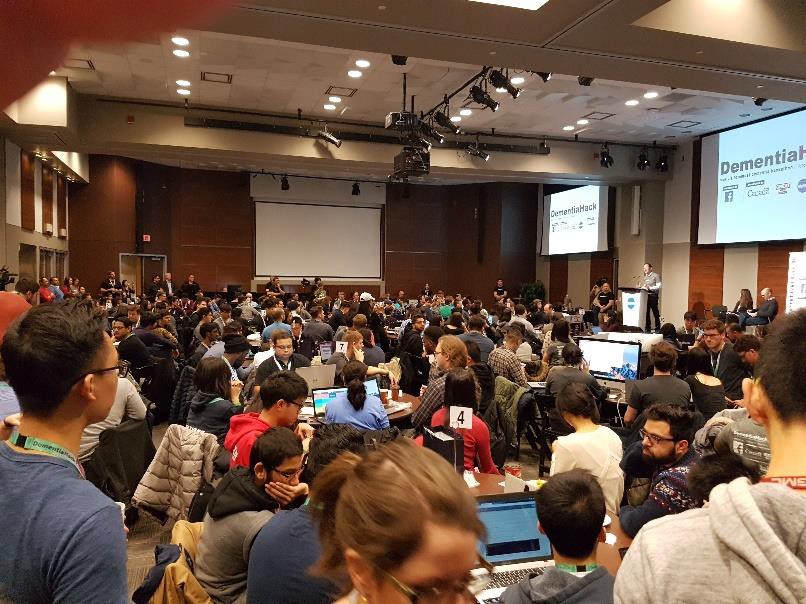
A modern day hackathon is an outstanding vehicle for experiential learning.
Today’s hackathon is NOT a wood chopping game or nefarious cybercrime activity – but rather a marathon coding competition. But, it’s not just about coding.. it’s a microcosm of the full development cycle and project management needed to build an information technology project. The success of a hackathon, just like any competition, is dependent on how well it’s produced and how well people connect to the cause. Incorporating “cause hackathons” into post-secondary, graduate and even secondary school curriculum produces lifelong learning experiences and tangible market/career value.
DementiaHack 2017, hosted at MaRS discovery district in Toronto, presented by Facebook, and championed by the Canadian and UK governments was an exemplary cause hackathon with incredible civic spirit, an urgent global cause and showcase of epic organizational skills. It was produced and organized by HackerNest: www.hackernest.com as a face-to-face event (not a virtual hackathon). A capacity 320 participants worked in teams to tackle problems faced by stakeholders in 4 challenge sets: person with dementia, their family caregivers, industry caretakers and researchers. A unique aspect of the DementiaHack was the mentoring process: mentors were subject matter experts from each of the four challenge sets, and they were also the judges. Close to 50 mentors were available to coach any team prior and during the event and also organized in online and interactive “Voices from the Field” panel. This provided the participants with deep insight into the requirements of the various stakeholder groups. Of the DementiaHack 2017 participants, over 50 were current and former students of mine from select programs at various GTA colleges. This was not a coincidence. This was purposefully done as an exercise in experiential learning.
My first introduction to a Hackathon was as an invited judge to “Hackernest Construct” http://hackernest.com/construct . This was held at Ryerson University DMZ in downtown Toronto. While I had experience hosting student competitions, what struck me was the creative energy, camaraderie, inclusiveness, exhaustion, extraordinary innovation and resourcefulness that comes from the highly restricted, competitive setting. The productivity is otherworldly… teams handily accomplished projects in a weekend what students in capstone project groups did in a semester. My thought: there must be more to this “RAD and “Agile” development talk!!
When DementiaHack was born in Toronto, the positive community energy was amplified by an order of magnitude because of the massive social cause and involvement of government sectors. A good percentage of the millennial participants were personally affected by living with dementia in the family and thus inspired to help. Again, I was grateful to be involved by HackerNest as a mentor.
By the second DementiaHack, held at the spectacular new George Brown waterfront campus, I was hooked.
Those familiar with Systems Analysis topics recognize various stages of the Systems Development Lifecycle (SDLC), such as planning, analysis, design, implementation and support. Tools such as “Functional Decomposition”, “SWOT Analysis”, “Problem Statement” “Data Flow Diagrams”, “Use
Cases”, “Class Diagrams” and processes such as “waterfall”, “JAD”, “agile” and “DevOps” support these stages. Those familiar with Project Management understand the five process groups: Initiating, Planning, Executing, Monitoring/Controlling, Closing as well as the various knowledge areas including stakeholder management, communications, human resources, time, scope, cost, quality, risk, quality etc. These are the very same stages, tools, processes required in a Hackathon…. just all within 30 hours.
Teaching these concepts from a text book is very difficult and possibly boring if students have little or no practical experience to relate this too.

So the DementiaHack 2.0 was the first time I experimented with having my classroom students voluntarily participate as an alternative to classroom-assigned case studies. After enormous, universal gratitude from the students, I became determined to do more. Also, since my oldest daughter teaches high school in the Toronto District School Board (TDSB), I thought it would be worthwhile to experiment whether high school programs can equally benefit. This came from personal experience: I “switched on” to computer programming at age 12, because my high school teacher provided me with access to an IBM System 360 Model 20 to experiment with coding in Basic Assembly Language. I too, was enormously grateful that someone gave me an opportunity to experiment and find my passion at an early age.
David Kolb from the University of Leicester helped to develop the modern theory of experiential learning in the 1980s. He states that the learner must have four abilities:
- The learner must be willing to be actively involved in the experience;
- The learner must be able to reflect on the experience;
- The learner must possess and use analytical skills to conceptualize the experience; and
- The learner must possess decision making and problem solving skills in order to use the new ideas gained from the experience.
So, now about DementiaHack 2017.
Readers can review the formal website at http://hackernest.com/dementiahack/ including all the challenge sets and winning entries. They can also get a detailed view of the online community that includes the dialog between mentors and teams, as well as the posting of all DementiaHack competitors at http://community.hackernest.com/c/hackathons/dementiahack
The purpose of this blog though is not to praise the winning teams, but rather the ALL the participants. It turns out that the cliché, “everyone is a winner” is true when it comes to DementiaHack.
With the support of the HackerNest organizers and the college, my approach to the hackathon was:
- Encourage all students in Systems Development class to form teams and enter the competition by promising high marks in return for spirited participation (not for winning or score per se)
- Encourage students in Project Management for IT to form entry teams or to volunteer with community building activities including high school liaison, CRM activities or HackerNest organization as their practicum.
- Encourage recent programming grads/student to participate as a method to boost their resume.
- Since the event was oversold, cull students/teams from the hackathon registrants above set if they were not serious or ready.
In our lectures prior to the Hackathon, we worked though topics such as stakeholder analysis, business case, system request, requirements definitions, user stories, data dictionary, UI Mock-ups, architecture choices as well as reviews of relevant PMBOK chapters. Student assignment were linked to their entries to DementiaHack and were reviewed and marked. We offered “drop-in workshops” in the evening for interested teams.
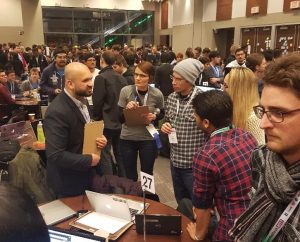
Just prior to the event, participants were nervous, anxious, excited and sometimes even terrified. Some only went because their professor “made them” and they needed the grades…. reluctant pehaps. But it only took a seconds upon arrival for participants to realize this was not going to be their average project assignment!
Fast forward to completion and each student was asked to conduct a final exam after the event which included major chapters reflecting on their learning experience. It also provided opportunities for unfiltered comments and quotes. So now, instead of speaking in abstract terms, I’ll let the pictures and participant quotes do the rest for me.
Ismael’s public blog article is reflective of how the hackathon accomplished Kolb’s abilities, especially reflection on the problems solving skills. “Now I understand that every single lecture was for getting us ready for D-day. At the end we were like a machine, thinking, mumbling and acting by instinct, making decisions on the fly, solving situations as they appear, we were using automatically what we had learned without even realizing it. I can’t imagine a class more practical than this.”
Asmita’s comments demonstrate her intense involvement and monumental learning outcomes:
Asmita: “Participating in the DementiaHack has been one of the most rewarding experiences I had in my life. True and honest community work, knowledge exchange and team integration are the cornerstone of this activities. Challenge yourself no fear the unknown and inspire yourself to learn more!!”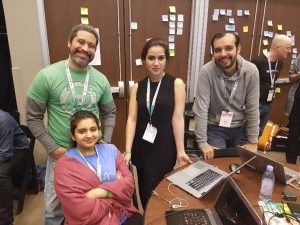
If I had to explain the top objective of a Systems Analysis class in a single sentence, it would be: “It’s crucial to analyze your stakeholders and collect their requirements before you build any code”. This lesson is excruciatingly hard to teach and counter to a programmers’ instincts. Yes, I can train the students to pick that answer from a multi-choice test.. but to really difficult to internalize it is the ultimate goal without learning from experience and having done it wrong first. So to hear the following as genuine, unsolicited outcomes is heart- warming tells me the goal was accomplished:
Figure 4 Even after an exhausting weekend… team is happy and proud
Victor: “The first lesson I learned… prior to any project we need to come up with idea, and then identify the stakeholders, needed requirements, objectives, constraints, and potential risks very carefully. We need to meet with stakeholders to understand the problem completely”
Nishma: “The most important lesson I learned is that planning and scoping of work should be detailed and made way ahead of the execution. Documenting user stories and acceptance criteria must had helped execution go smoother”
Daniel: “First, I will work more with stakeholders to understand the requirements in detail. Also, I will communicate frequently to secure the stakeholders engage in the project.”
Oleksandr: “If your goal is to win DementiaHack, you should spend much more time on planning and analyzing requirements”
There were many kudos to the organization. The event itself including the facility, crowd, news coverage, appearance of Mayor, support from senior executives from Facebook, Public Health Canada, UK Government, Home Instead, RBC, etc. Continuous weekend TV coverage on CP24, documentary filming, reporters, bloggers all added to the excitement.,
John: “The energy in the room was really motivating and remarkable. VIPs such as Facebook Executive and Mayor Tory appearance lifted the room”
Figure 5. Toronto Mayor John Tory chats with TDSB team prior to event start
Figure 6. Media is present and is creating documentaries and news coverage including CP24 live feed…these guys are popular!!
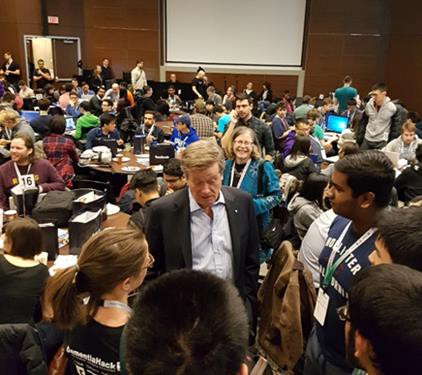
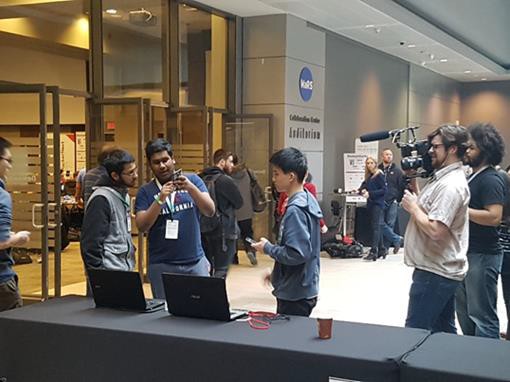
The following comment selections reflect the impact of having epic organization:
Nishma: “Energized participants, excited about this event as well as about their concept. John Tory, Mayor of Toronto, Media,CP24, we were on TV….Yay! I wasn’t aware this event was that big.”
Victor: “It was a big experience for me. The biggest surprise was the good organization of this event.”
Jenner: “There was amazing community support and collaboration environment. The genuine interest in helping the community to face and resolve the social and humanitarian issues”.
Asmita: “I have experienced this kind of event for the first time. Being an international student I was so overwhelmed by the fact that for continuous 36hrs we’ll have to work and be at some center with so many other participants but oh my god! It was such a beautiful experience. It was so well organised and the venue was just awesome. Hats off to the organizers, it was all a surprise to me.”
The judging “science-fair-style” method was a final, ruthless experiential learning experience for the students. When we first started, weeks before the project, students struggled to tell me what their projects were at all. When we got closer to the event, they struggled to explain their problem statement or project outline it in 20 minutes or less. I spent plenty time lecturing the merits of having an “elevator” pitch in class. This is not something you need just for Systems Analysis… you need it for life!!. . When the judging time was nigh on Sunday afternoon students had THREE MINUTES to present their entire project and demo to the judge with 1 minutes for questions. Furthermore, because of the formal of the judging, they HAD TO REPEAT IT UP TO 6 TIMES FOR EACH JUDGE SET. We’ll have Pooja describe the process for us:
Pooja: Each team was asked to present their product within only 3 mins repeatedly for each set of judges and every time we did that, our product was even better understood by both the parties and we quoted the best features of our product. Participating in DementiaHack is the best possible way anyone would practically learn time management, resource allocation, creative thinking, error free implementation and solid marketing skills”
The participants understood their product strengths and weakness well by the time they were done presenting and accepted the judges verdict as reflected in the following quote:
John: The eventual winners of my chosen challenge set had the same idea. They had the edge on the use of UX. To win the hackathon together with an interest gauged idea, the UX should be mouth-watering: presentation matters.
Figure 7 Slayin’ the presentation to the judges
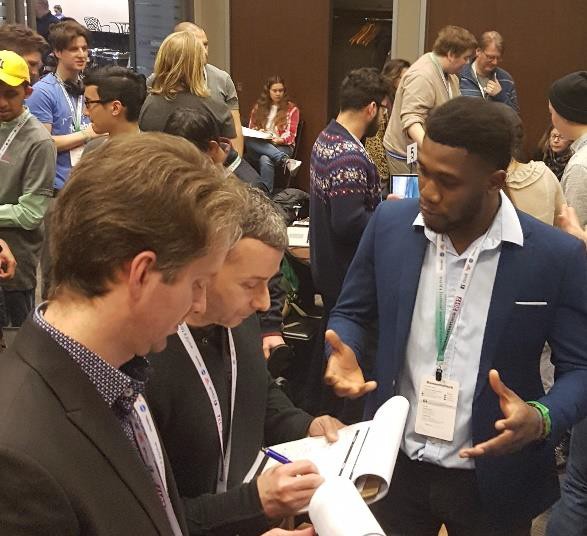
So now I’m working with my program coordinator to figure out how to work more Hackathons into our curriculum. Our eyes are set on “FishHack” with is sponsored by the US State Department and also organized by HackerNest. Some summary quotes to highlight the experiential learning value:
Bita: “In general, experiential learning is valuable a lot more to me: never can compare with theoretical learning”
Volodymyr: “A Hackathon is very useful and interesting thing which forces you to think about important problems and generate ideas to solve them. I would advise to do experiential learning more often because it is more interesting and useful.”
Ismael’s comment aligns well with the ultimate goal of Dementiahack, namely: build solutions to tackle challenges in dementia, Alzheimer’s, and other neuro-degenerative diseases and bring them to market.
Ismael: “This experience was mind blowing, I would suggest to have more practical cases like this in other classes. For me this DementiaHack opened a world of possibilities, it has ignited the spark of going further, of not letting it be part of the past, embrace my idea and make it happen. I’m totally looking into forming a start-up and making it happen. Thanks for this great opportunity of learning through a real life experience like this”
Essential Employability Skills of Fundamentals of Systems Development:
- Communicate clearly, concisely and correctly in the written, spoken and visual form that fulfils the purpose and meets the needs of the audience.
- Respond to written, spoken, or visual messages in a manner that ensures effective communication.
- Apply a systematic approach to solve problems.
- Show respect for diverse opinions, values, belief systems, and contributions of others.
- Interact with others in groups or teams in ways that contribute to effective working relationships and the achievement of goals.
- Take responsibility for one’s own actions, decisions, and consequences.
I reflect on the publically available leading objectives, taken verbatim, for the course and say: WE DID THAT….MISSION ACCOMPLISHED.
Pooja shall have the final comment:
Pooja: “Participating in DementiaHack was one of the best decisions of my life. It was an ultimate learning experience where I was the team lead and presenter for my product. It was unbelievable how we sailed through every phase of a Software Development Life Cycle in just 2 days and how beautifully we could assemble it in a 3 minute presentation!”
References:
- Ismael Romero: linkedin blog https://www.linkedin.com/pulse/what-i-learned-from-dementiahack- 2017-ismael-romero
- Kolb: Experiential Learning Model http://www2.le.ac.uk/departments/gradschool/training/resources/teaching/theories/kolb
- Seneca College News: http://www.senecacollege.ca/collegenews/articles/03-06-01.html
- Seneca College Project Management for IT Post Graduate Program MC Program: http://www.senecacollege.ca/cgi-bin/subject?s1=PMC130
- Sheridan College Capstone competition: http://serc.sheridaninstitute.ca/academics/faculties/applied- science-and-technology/applied-computing/events.aspx
- Sheridan College Annual Systems Analyst Capstone Competition: https://www.linkedin.com/pulse/2015-annual-capstone-competition-sheridan-systems-analsyst- buchner
- HackerNest: www.hackernest.com/dementiahack
*This work is licensed under a Creative Commons Attribution-NonCommercial-NoDerivatives 4.0 International License

